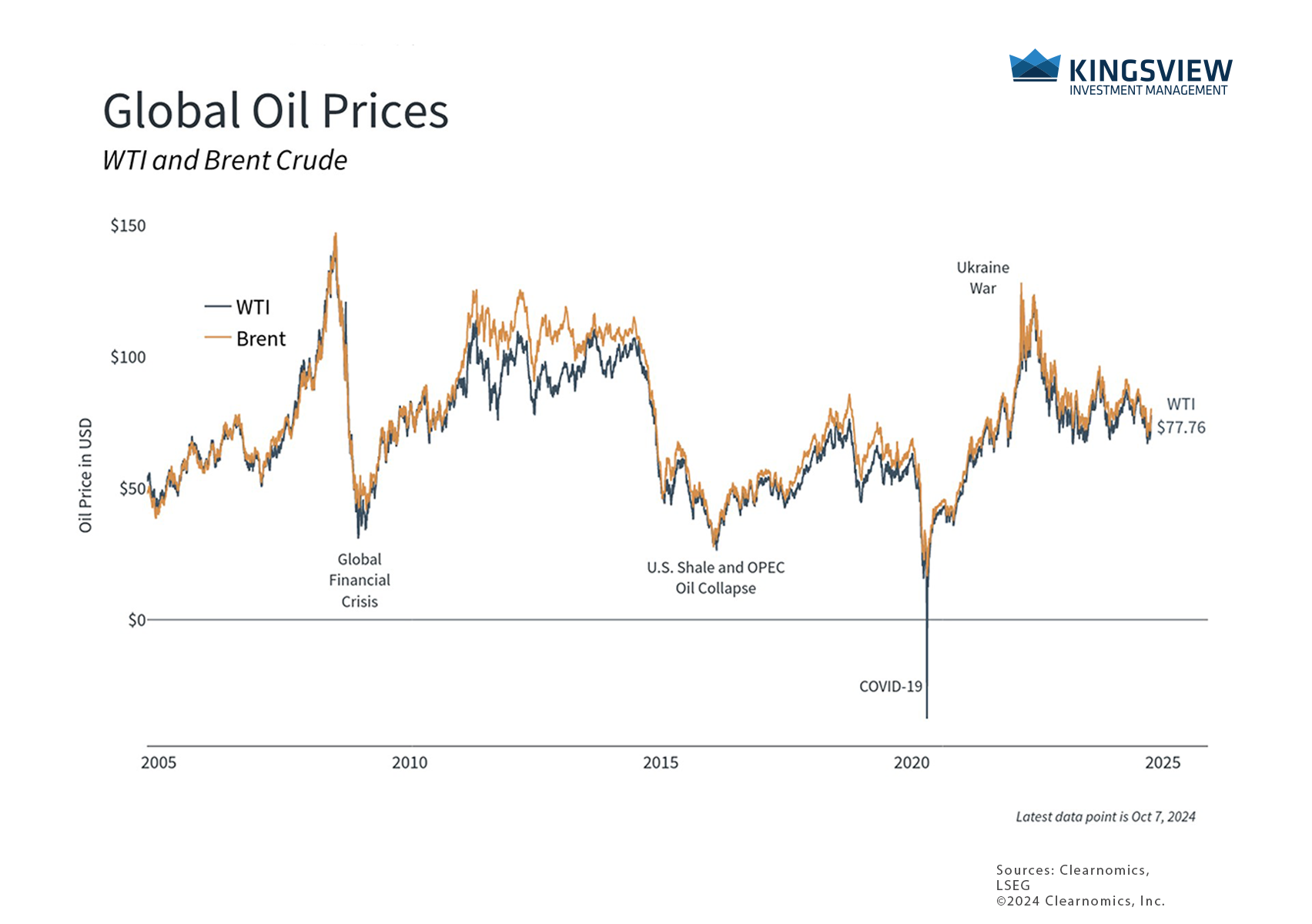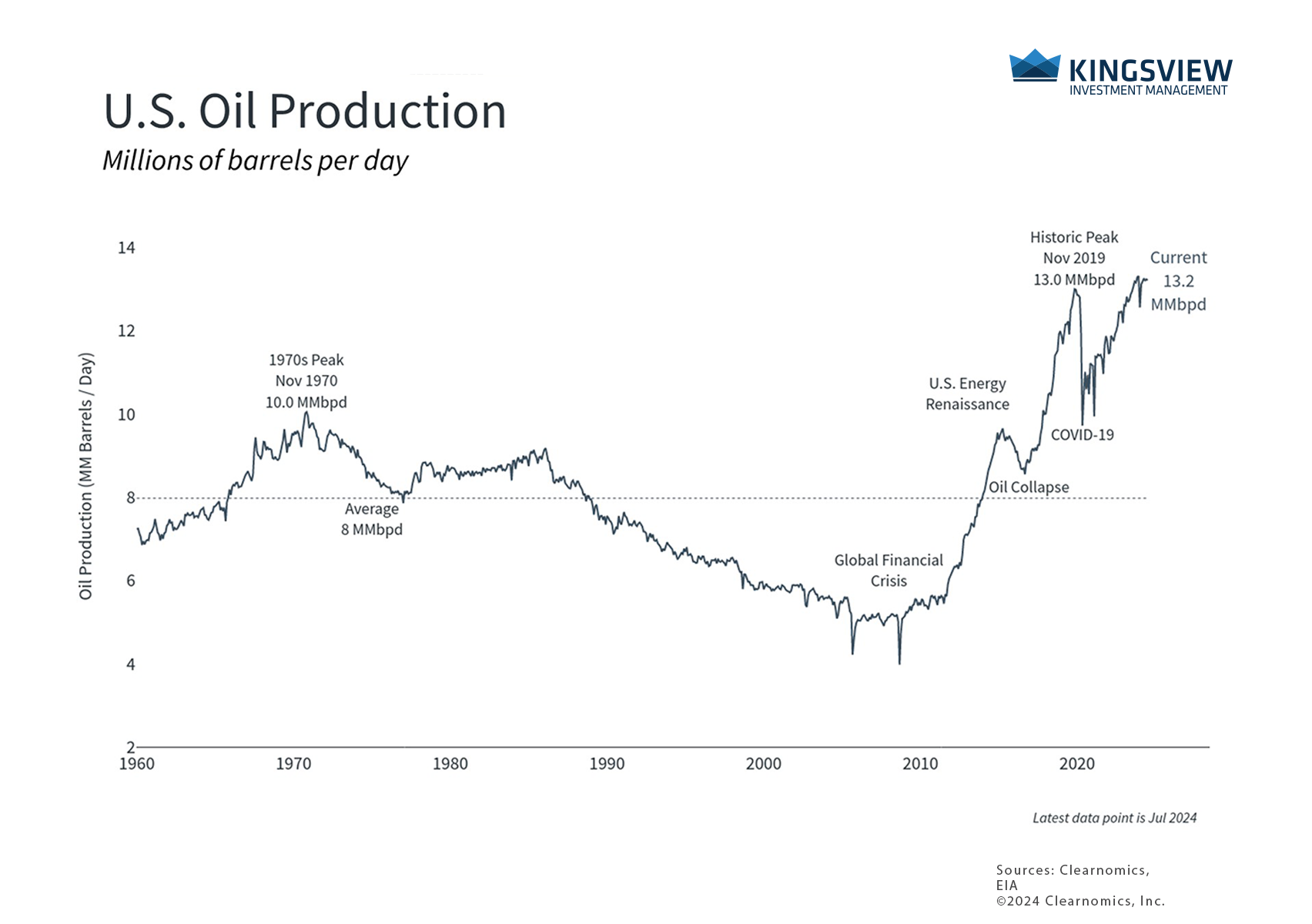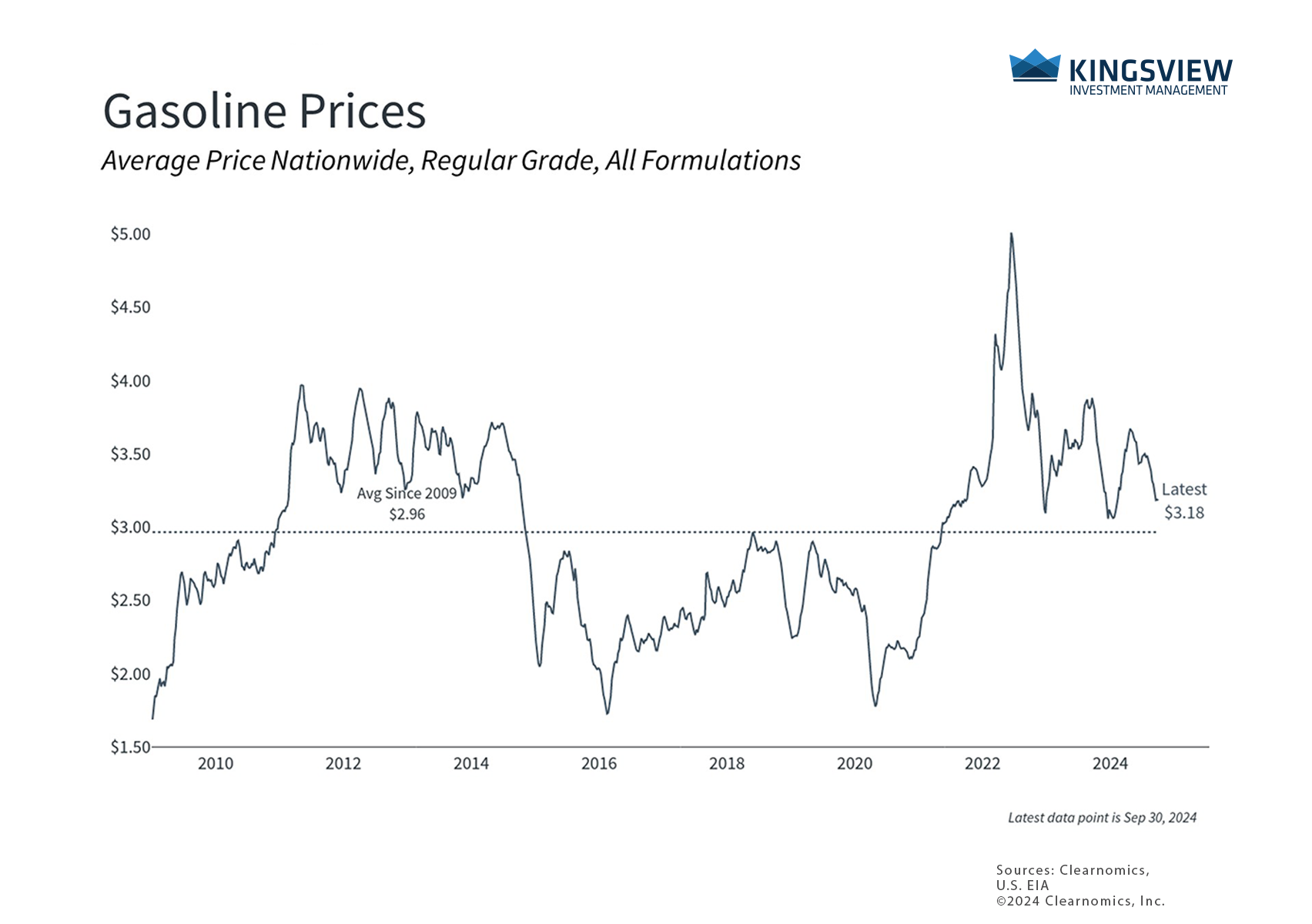Portfolio Manager Insights | How Rising Oil Prices Affect Investors 10.9.24
Click here to download this commentary in PDF format.
Oil prices play an important role in the global economy, directly influencing the cost of gasoline at the pump and indirectly impacting the prices of all goods and services. The price of oil has also been an important factor influencing global markets and inflation trends over the past few years. Historically, the relationship between oil and the economy is a two-way street: low or stable oil prices stimulate the economy, and a growing economy increases the demand for oil, and vice versa.
Although prices have fallen from their 2022 high, they have risen recently amid a spike in geopolitical tensions and the potential risk to oil supply. The escalating conflict in the Middle East, which began a year ago with Hamas’s October 7 attack on Israel, is concerning and has significant humanitarian consequences. While acknowledging the human side of the conflict, some investors may wonder what trends in oil prices may mean for their portfolios and the broader economy in the coming months.
Oil is sensitive to geopolitics and economic growth

The price of Brent crude, the global oil benchmark, recently jumped to $78 per barrel due to the conflict between Israel and Hezbollah/Iran. While this represents a 13% increase from the recent low of $69 a month ago, oil prices are still roughly flat on the year and far below the 2022 peak of nearly $128. Oil prices can be volatile and difficult to predict, but fears that the conflict in the Middle East would send prices skyrocketing above $100 a barrel have so far not materialized.
Historically, oil prices are influenced by both geopolitics and economic growth. While conflicts can cause prices to spike, as they did when Russia invaded Ukraine, sustained increases in oil prices have more often been the result of rising demand due to strong economic growth. The historic level of oil prices during the mid-2000s, for instance, was the result of rapid global growth prior to the 2008 housing crash and global financial crisis. Thus, geopolitics and growth tend to impact supply and demand, respectively, which can affect how long prices stay high and the resulting effects.
The U.S. is the world’s largest producer of oil and gas

One reason the distinction between supply- and demand-driven shocks matters is because oil producers can respond to changing prices. Unlike in the mid-2000s, the U.S. is now the world’s largest producer of crude oil. Advancements in exploration and drilling have increased output, allowing the industry to maintain high productivity levels. According to the Energy Information Administration, these improvements have been key to sustaining U.S. oil production growth which now exceeds 13.2 million barrels per day.
In theory, this means that the U.S. can play the role of “swing producer” to increase supply when oil prices are high. Of course, this is an oversimplification since the U.S. still relies on foreign imports due to the different types of crude oil needed by refineries as well as the effects of various energy policies. Nonetheless, it helps to insulate the U.S. from geopolitics and possibly reduces the impact of oil shocks.
In the long run, world oil production is expected to outstrip demand over the next several years, according to the International Energy Agency. This is partly due to U.S. production, but it also reflects the changing dynamics of OPEC+. The group has extended production cuts into 2025 in order to maintain higher oil prices, although the incentives to renege on these commitments to gain market share are high among member countries. This has made the cartel less relevant over the past decade.
Despite these trends and the growing adoption of renewable energy sources, the world remains heavily reliant on oil, which means that it still serves as a transmission mechanism for geopolitical tension to influence the global economy. A further spike in oil prices could act as a headwind to the economy and the “soft landing” the Fed is hoping to achieve. At the same time, there are many factors that make this less likely than in the past.
Gasoline prices remain relatively low

Perhaps the biggest impact of higher oil prices on everyday consumers is via gasoline prices at the pump. Fortunately, gasoline prices remain far lower than their peak in 2022 when the average price per gallon of regular unleaded reached $5. This led the Department of Energy to begin releasing oil from the Strategic Petroleum Reserve (SPR), an emergency supply of crude maintained by the government. Since then, the government has been refilling the SPR at more attractive prices.
Higher gasoline prices are effectively a tax on households and consumers since driving to work, school, and buying groceries are necessities. Higher gas prices also reduce disposable income for other purchases, especially larger discretionary items, which can impact retail sales and corporate earnings.
From an investment perspective, navigating oil price fluctuations can be challenging especially if they are the result of uncertain or troubling geopolitical developments. The performance of the energy sector during periods of market stress illustrates this point. In 2022, when the broader S&P 500 index was down 18% and most sectors posted negative returns, the energy sector delivered a remarkable 66% gain. This followed a 55% return in 2021 for the sector when the economy roared back after the pandemic.
While past performance does not guarantee future results, maintaining a diversified portfolio that includes many sectors, including energy, can help investors to offset the volatility that results from rising oil prices. In the long run, holding a portfolio that can weather market swings allows investors to stay focused on their long-term financial goals.
The bottom line? Oil prices have risen due to Middle East tensions but remain well below their recent peaks. While oil can impact economic growth, investors should focus on maintaining broad sector exposures in their portfolios and avoid overreacting to daily headlines.
Historical references do not assume that any prior market behavior will be duplicated. Past performance does not indicate future results. This material has been prepared by Kingsview Wealth Management, LLC. It is not, and should not, be regarded as investment advice or as a recommendation regarding any particular security or course of action. Opinions expressed herein are current opinions as of the date appearing in this material only. All investments entail risks. There is no guarantee that investment strategies will achieve the desired results under all market conditions and each investor should evaluate their ability to invest for the long term. Investment advisory services offered through Kingsview Wealth Management, LLC (“KWM”), an SEC Registered Investment Adviser. (2024)
